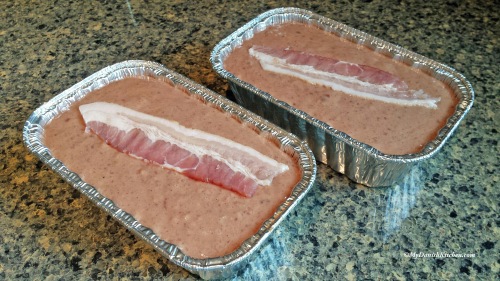Can you have too many Leverpostej recipes? Never! The more the merrier. This is a wonderful Leverpostej loaded with flavor. Serve it warm with sautéed mushrooms and maybe some extra bacon. This recipe is less complicated than my original Leverpostej recipe and has just a couple more ingredients than my Easy Leverpostej. If you have a food processor it’s so easy to make, or you can always make it the danish way by running the first four ingredients through a meat grinder twice and then adding remaining ingredients.
For this recipe I wrote it up to make a full portion (which makes 5-6 small loaf pans or 3 large loaf pans) or if you want to make only half the amount, measurements are in parentheses. I personally only make half of a portion since we don’t eat Liver pate every day. If not baking right away, store the unbaked pate in the freezer.
Leverpostej (full portion makes 5-6 small or 3 large loafs)
Ingredients:
600 g or 21 oz Calf liver (300 g)
170 g or 6 oz onion (85 g)
90 g or 3.2 oz mushrooms (45 g)
240 g or 8.5 oz bacon (120 g)
250 g or 8.8 oz butter (125 g)
200 ml or 6.8 fluid oz heavy whipping cream (100 ml)
75 g or 2.6 oz flour (38 g)
2 egg (1)
20 g or 0.7 oz anchovy paste (10 g)
1/2 tsp better than bouillon paste, beef (1/4 tsp)
1 tsp salt (1/2 tsp)
1/2 tsp pepper (1/4 tsp)
1 tsp allspice (1/2 tsp)
1 tsp paprika (1/2 tsp)
Directions:
Melt butter and set aside. Cut liver, onion, mushrooms and bacon into chunks. Place onion, mushrooms and bacon into food processor and process until coarse. Add liver and process until well incorporated. Add heavy whipping cream to butter, add mixture to food processor. Add flour, egg, anchovy paste, better than bouillon paste, salt, pepper, allspice and paprika, process until smooth (several minutes).
Pour into small aluminum forms and if freezing cover top tightly with aluminum foil and store in freezer safe bags. When ready to cook Liver Pate, fill an oven-proof dish with warm water 1/2 way up the side of aluminum form. Bake uncovered in oven at 200 degree C (390 degrees F) for 1 hour 30 minutes. Enjoy!
Source: slightly adapted from Sweet, Sour, Savory























